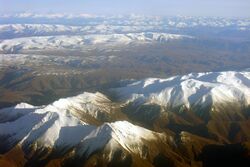Biology:Hierodoris gerontion
| Hierodoris gerontion | |
|---|---|
| Scientific classification | |
| Domain: | Eukaryota |
| Kingdom: | Animalia |
| Phylum: | Arthropoda |
| Class: | Insecta |
| Order: | Lepidoptera |
| Family: | Oecophoridae |
| Genus: | [[Biology:|Hierodoris]] |
| Species: | H. gerontion
|
| Binomial name | |
| Hierodoris gerontion Hoare, 2005[1]
| |
Hierodoris gerontion is a moth of the family Oecophoridae.[1] It is endemic to New Zealand and is found in the alpine zones of the mountain ranges in Central Otago. This species prefers habitat near seepages and is also common in fellfields. H. gerontion is variable in appearance with the hindwings varying in appearance from white to a darkened brownish shade. It can be distinguished from other species in the Hierodoris genus as on the second segment of the labial palpi it has sub-erect scales giving the appearance of a shaggy beard. The larvae of this species has yet to be described.
Taxonomy
This species was first described by Robert Hoare in 2005 from specimens collected in Central Otago.[1] The male holotype specimen, collected at the Old Man Range / Kopuwai at 1640 m, is held at the New Zealand Arthropod Collection.[1]
Description
H. gerontion is variable in appearance but the wingspan of an adult is between 14.5 and 17.5 mm.[1] The hindwings can vary in appearance from white to a darkened brownish shade.[1] It can be distinguished from other species in the Hierodoris genus as on the second segment of the labial palpi it has sub-erect scales giving the appearance of a shaggy beard.[1] The larvae of this species has yet to be described.[1]
Distribution
This species is endemic to New Zealand and is found in the alpine zones of the mountain ranges in Central Otago.[1][2] Although originally this species was said to be present in eastern Fiordland this locality information was based on an incorrect identification of a male specimen of H. extensilis.[3]
Habitat and hosts
This species prefers habitat near seepages and is also common in fellfields.[1][4] As at 2005 the larval host is unknown but it has been hypothesised that the larval hosts may be herbaceous plant foliage.[1]
References
- ↑ 1.00 1.01 1.02 1.03 1.04 1.05 1.06 1.07 1.08 1.09 1.10 , pp. 32-33, Wikidata Q44994400
- ↑ "Hierodoris gerontion Hoare, 2005". https://www.nzor.org.nz/names/e983820c-2109-4f16-b9dc-cb10ba4c45f8.
- ↑ , Wikidata Q54578048
- ↑ "Crown Pastoral Land Tenure Review. Obelisk Station PO 264 Conservation Resources Report - Part 4". December 2010. https://www.linz.govt.nz/system/files_force/media/crown-property-attachments/tenure-review/ig/obelisk-conservation-resource-report-pt4.pdf?download=1.
Wikidata ☰ Q21271031 entry
 |


